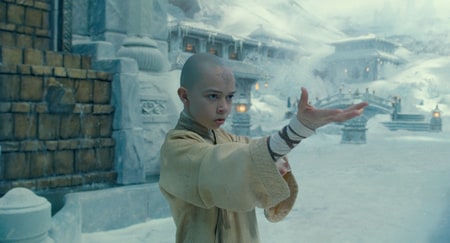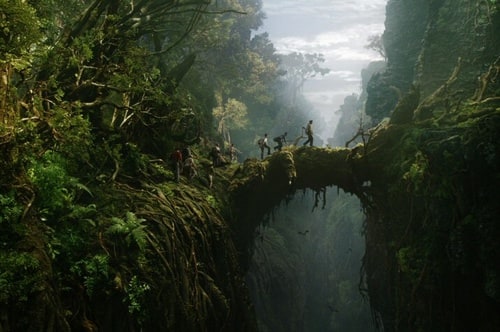Coming off back-to-back disappointments with Lady in the Water and The Happening, M. Night Shyamalan has fallen quite far since the day in 2002 when he was declared "The Next Spielberg" by Newsweek. 2010's The Last Airbender seemed like Shyamalan's one last chance to win back his fans and prove that he still has the ability to craft a great movie. Alas, it simply was not to be, as the film instead denotes the continuation of Shyamalan's downward spiral. Working for the first time on a project derived from pre-existing material, the filmmaker was at a total loss of how to revamp the Nickelodeon TV series Avatar: The Last Airbender into a free-standing live-action blockbuster that's suitable for general audiences (guess why the Avatar appendage was removed). The finished product is nothing short of an incomprehensible fiasco; a disjointed, painfully generic, utterly boring special effects extravaganza with awful acting, subpar editing, no heart, and no real purpose. If one replaced Shyamalan's name with "Alan Smithee" in the credits, The Last Airbender would just be another big-budget misfire. Yet, with Shyamalan at the helm, the film also seals the fate of a once-talented filmmaker.

The Last Airbender takes place in a fantasy world that's divided among four tribes, each of which represents one of the fundamental elements: Earth, Air, Water and Fire. Within each of these tribes are "benders", who are endowed with the gift of being able to control an element with their minds. It's been 100 years since the four nations have lived in harmony. It has also been 100 years since the disappearance of the Avatar; the only living being able to control, or "bend" all four elements, and thus maintain balance throughout the elemental world. Consequently, the world is on the brink of catastrophe. As fate would have it, two young people - hunter/warrior Sokka (Rathbone) and his water bender sister Katara (Peltz) - stumble upon a mysterious boy named Aang (Ringer), who turns out to be the long-lost Avatar. Soon, Aang begins training in the art of bending all of the elements; honing his skills to fulfil his destiny as the one who can restore balance to the previously harmonious world.
The Last Airbender is something akin to Crouching Tiger Hidden Dragon meets The Karate Kid meets Star Wars, but it's not nearly as good as the aforementioned films. The otherworldly sights and lands in the movie were brought to life with virtually seamless visual effects, but the script is botched. The picture limps forward at a snail's pace; treating its own mythology as homework and its characters as burdens. It's hard to express how truly off-putting Shyamalan's screenplay is - it's overwrought and undercooked; a whirlwind of plot points and events without an understanding of cohesion or where to focus attention. There's a lot of awkward, clunky exposition as well. Worse, the characters are ineffectually one-note, emotionally-cold ciphers which move like chess pieces throughout the complex narrative machinations. A romance develops out of nowhere between characters we don't care about, too. And a lot of things, such as Aang's ability to drop in a trance and speak with a dragon spirit, are poorly motivated and baffling.

Shyamalan is a master of suggestion and suspense-building, but The Last Airbender demanded the exact opposite: it's a blockbuster for which nothing is left to the imagination. Thus, the director discarded his traditional approach in favour of something bigger, more obvious, and more in-your-face. The best thing which can be said about the filmmaking is that Shyamalan did not fall prey to the current trend of hacking action scenes into a million incoherent flashes. Instead, Shyamalan and cinematography Andrew Lesnie (who shot the Lord of the Rings trilogy and King Kong for Peter Jackson) used elegant long takes to allow for viewers to soak in the imagery. It makes for an interesting twist on routine summer-movie battles, yet there's no sense that anything is at stake. Consequently, the action never rises above its rapidly diminishing "wow" factor; making the film's final stretches feel long and tiresome, rather than compelling and exhilarating. In addition, as was done with Clash of the Titans, Shyamalan's The Last Airbender was hastily, messily and unnecessarily converted to 3-D for the sole purpose of sucking as much money as possible from unsuspecting consumers. The results are absolutely disastrous; soaking the brightness and clarity out of every frame. ILM's digital effects are impressive, but the 3-D effects ruin the CGI work.
Even Al Pacino and Robert De Niro would be unable to overcome Shyamalan's awful writing and inane dialogue, and thus the film is only worsened by a terrible cast. The only word which can be used to describe the acting is embarrassing. Did Shyamalan try to save money by doing his casting at junior high school drama productions? With thousands of child actors available, it's baffling as to why the director didn't choose performers who could display emotions with conviction or recite lines without sounding as if they're reading from a teleprompter. As Aang, newcomer Noah Ringer is wooden and charisma-free. Jackson Rathbone and Nicola Peltz are similarly contrived, and share no distinguishable sibling camaraderie as Sokka and Katara. Only Dev Patel (last seen in Slumdog Millionaire) is somewhat convincing as Prince Zuko.

The Last Airbender at least enjoys excellent production values, an effective score by James Newton Howard, and a general technical competency which meets usual big-budget production standards. Viewed as a series of fantastical snapshots, The Last Airbender is fairly impressive. Nevertheless, this is a movie rather than a Photoshop portfolio, and it's a woefully empty film at that. If Shyamalan aimed to deliver a message behind all of the action, it was lost in translation. And if the filmmaker hoped to bring some feeling to the characters and story, he missed the mark by a country mile. If only there was a semblance of substance to back up the bold aesthetics. The Last Airbender was produced for a mammoth $150 million, but alas not a cent of that went into script polishing or casting. The biggest kicker is the ending, which boldly sets up a sequel. But honestly, who would want to see a sequel if the first film cannot be done right? It was an interesting experiment to let Shyamalan handle a big-budget spectacle, but The Last Airbender shows that the filmmaker should return to territory that better suits his talents.
3.2/10
 Login
Login
 Home
Home 183 Lists
183 Lists 1670 Reviews
1670 Reviews Collections
Collections
 0 comments,
0 comments, 


































